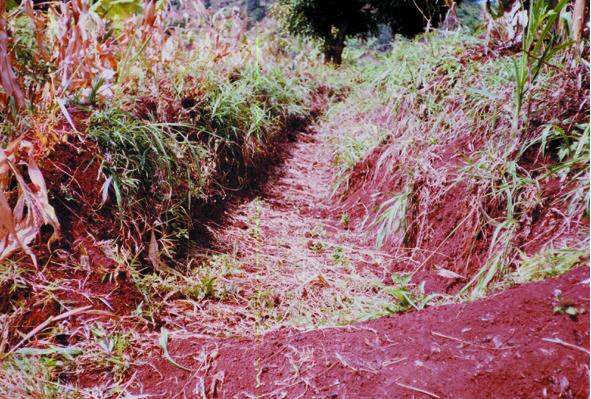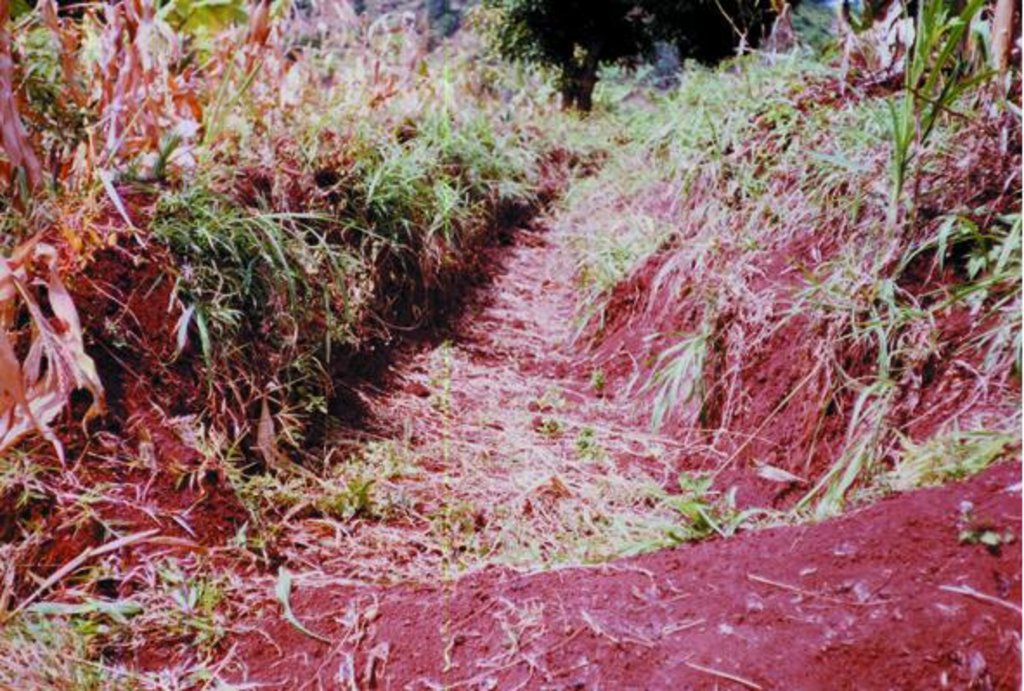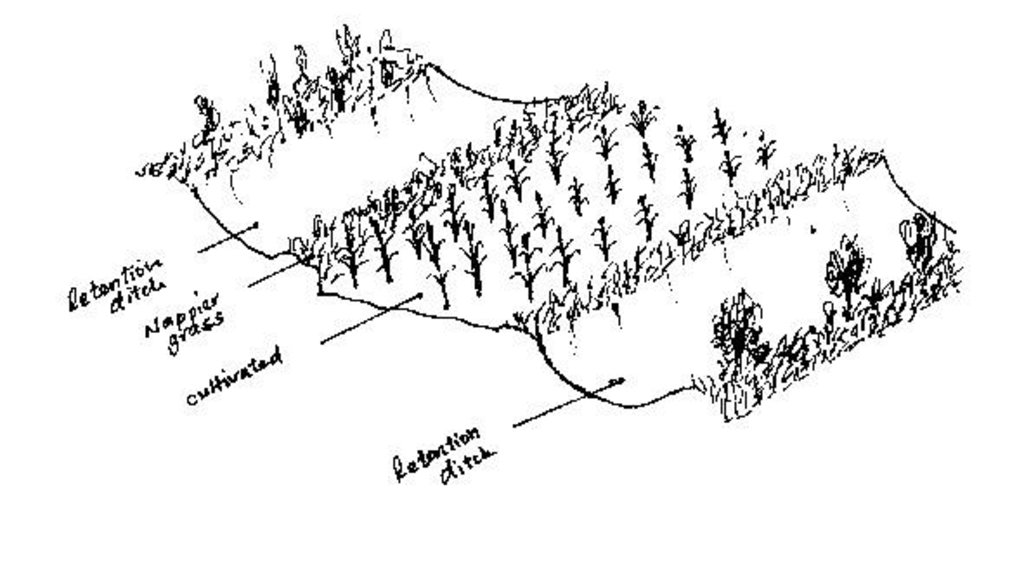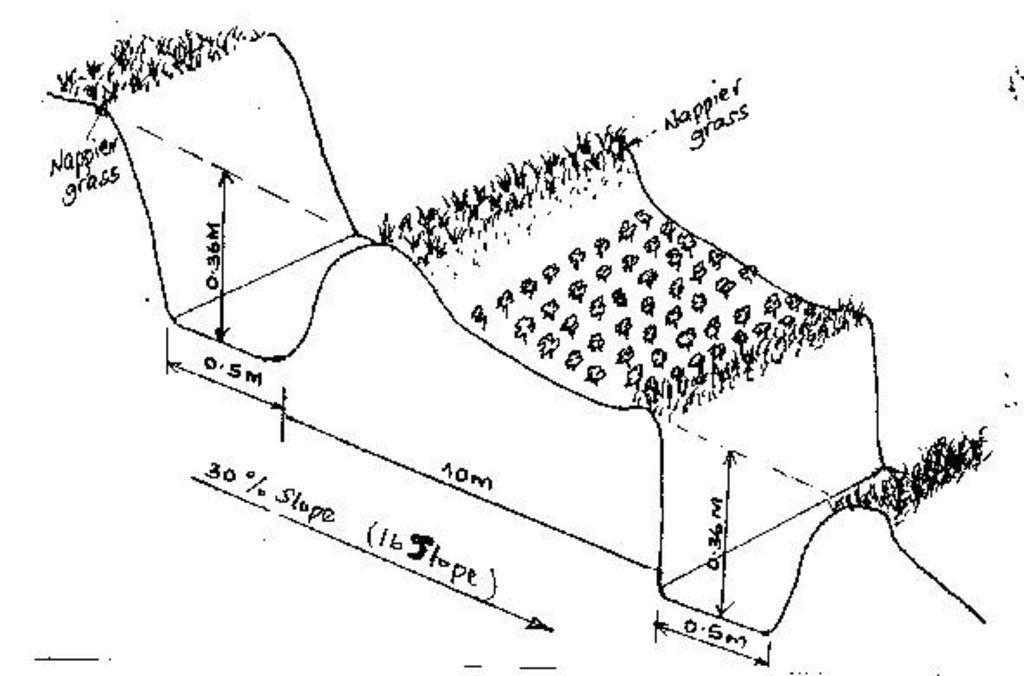Retention ditch Murang'a [Kenya]
- Creation:
- Update:
- Compiler: Unknown User
- Editor: –
- Reviewer: David Streiff
Nyakinyua
technologies_1485 - Kenya
View sections
Expand all Collapse all1. General information
1.2 Contact details of resource persons and institutions involved in the assessment and documentation of the Technology
Name of the institution(s) which facilitated the documentation/ evaluation of the Technology (if relevant)
Ministry of Agriculture and Livestock Development of Kenya (MoA) - Kenya1.3 Conditions regarding the use of data documented through WOCAT
When were the data compiled (in the field)?
05/05/1999
The compiler and key resource person(s) accept the conditions regarding the use of data documented through WOCAT:
Ja
2. Description of the SLM Technology
2.1 Short description of the Technology
Definition of the Technology:
A ditch across the slope for trapping /retaining runoff to encourage infiltration
2.2 Detailed description of the Technology
Description:
Constructed at zero gradient with closed ends, wide and deep to hold all expected runoff. The purpose is prevent the concentrated runoff from reaching the cultivated land. It is manually constructed and maintenance is seasonal.It is used where soils are deep , stable and well drained. These structures are unsuitable in areas susceptible to land slides . They are also not very suitable in areas with very deep soils that are not stable.
2.3 Photos of the Technology
2.5 Country/ region/ locations where the Technology has been applied and which are covered by this assessment
Country:
Kenya
Region/ State/ Province:
Central
Map
×2.6 Date of implementation
If precise year is not known, indicate approximate date:
- less than 10 years ago (recently)
2.7 Introduction of the Technology
Specify how the Technology was introduced:
- through projects/ external interventions
Comments (type of project, etc.):
Introduced by Ministry of agriculture extension staff through the elapesd national soil and water conservation programme.
3. Classification of the SLM Technology
3.1 Main purpose(s) of the Technology
- reduce, prevent, restore land degradation
3.2 Current land use type(s) where the Technology is applied

Cropland
- Annual cropping
- Tree and shrub cropping
Comments:
Major land use problems (compiler’s opinion): Soil erosion and loss of soil fertility
Major land use problems (land users’ perception): Soil erosion, high cost of farm inputs, poor infrastructure .
Type of cropping system and major crops comments: maize, potatoes and beans planted at the beginning of the rainy season.
3.3 Further information about land use
Water supply for the land on which the Technology is applied:
- rainfed
Specify:
Longest growing period in days: 120 Longest growing period from month to month: Mar - Jul Second longest growing period in days: 90 Second longest growing period from month to month: Oct - Dec
3.4 SLM group to which the Technology belongs
- water diversion and drainage
3.5 Spread of the Technology
Specify the spread of the Technology:
- evenly spread over an area
If the Technology is evenly spread over an area, indicate approximate area covered:
- 1-10 km2
Comments:
Total area covered by the SLM Technology is 2.5 m2.
The area is agroecological zone UM3 and occupied by about 320 farmers
3.6 SLM measures comprising the Technology

structural measures
- S4: Level ditches, pits
3.7 Main types of land degradation addressed by the Technology

soil erosion by water
- Wt: loss of topsoil/ surface erosion
- Wg: gully erosion/ gullying

water degradation
- Ha: aridification
Comments:
Main type of degradation addressed: Wt: loss of topsoil / surface erosion
Secondary types of degradation addressed: Wg: gully erosion / gullying, Ha: aridification
3.8 Prevention, reduction, or restoration of land degradation
Specify the goal of the Technology with regard to land degradation:
- reduce land degradation
4. Technical specifications, implementation activities, inputs, and costs
4.1 Technical drawing of the Technology
4.2 Technical specifications/ explanations of technical drawing
Technical knowledge required for field staff / advisors: moderate
Technical knowledge required for land users: low
Main technical functions: control of concentrated runoff: retain / trap, increase of infiltration, water harvesting / increase water supply
Construction material (earth): placed on the lower side of the ditch
Lateral gradient along the structure: 0%
Vegetation is used for stabilisation of structures.
4.3 General information regarding the calculation of inputs and costs
other/ national currency (specify):
Kenya shilling
Indicate exchange rate from USD to local currency (if relevant): 1 USD =:
78.0
Indicate average wage cost of hired labour per day:
1.50
4.4 Establishment activities
| Activity | Type of measure | Timing | |
|---|---|---|---|
| 1. | excavation | Structural | dry spell |
| 2. | planting of grass on the embarkment | Structural | on set of rains |
| 3. | None | None | |
| 4. | None | None |
4.5 Costs and inputs needed for establishment
Comments:
Duration of establishment phase: 12 month(s)
4.6 Maintenance/ recurrent activities
| Activity | Type of measure | Timing/ frequency | |
|---|---|---|---|
| 1. | desilting channel | Structural | dry spell/twice per year |
| 2. | gapping the napier grass | Structural | wet season/twice per year |
4.7 Costs and inputs needed for maintenance/ recurrent activities (per year)
Comments:
length of 1 m structure (retention ditch).
4.8 Most important factors affecting the costs
Describe the most determinate factors affecting the costs:
labour availability, depth/width of ditch. The cost of labour
5. Natural and human environment
5.1 Climate
Annual rainfall
- < 250 mm
- 251-500 mm
- 501-750 mm
- 751-1,000 mm
- 1,001-1,500 mm
- 1,501-2,000 mm
- 2,001-3,000 mm
- 3,001-4,000 mm
- > 4,000 mm
Agro-climatic zone
- humid
- sub-humid
5.2 Topography
Slopes on average:
- flat (0-2%)
- gentle (3-5%)
- moderate (6-10%)
- rolling (11-15%)
- hilly (16-30%)
- steep (31-60%)
- very steep (>60%)
Landforms:
- plateau/plains
- ridges
- mountain slopes
- hill slopes
- footslopes
- valley floors
Altitudinal zone:
- 0-100 m a.s.l.
- 101-500 m a.s.l.
- 501-1,000 m a.s.l.
- 1,001-1,500 m a.s.l.
- 1,501-2,000 m a.s.l.
- 2,001-2,500 m a.s.l.
- 2,501-3,000 m a.s.l.
- 3,001-4,000 m a.s.l.
- > 4,000 m a.s.l.
Comments and further specifications on topography:
Slopes on average: Also moderate
5.3 Soils
Soil depth on average:
- very shallow (0-20 cm)
- shallow (21-50 cm)
- moderately deep (51-80 cm)
- deep (81-120 cm)
- very deep (> 120 cm)
Soil texture (topsoil):
- coarse/ light (sandy)
- medium (loamy, silty)
Topsoil organic matter:
- medium (1-3%)
- low (<1%)
If available, attach full soil description or specify the available information, e.g. soil type, soil PH/ acidity, Cation Exchange Capacity, nitrogen, salinity etc.
Soil fertility is low - medium
Soil drainage / infiltration is medium - good
Soil water storage capacity is medium - high
5.6 Characteristics of land users applying the Technology
Off-farm income:
- less than 10% of all income
Relative level of wealth:
- poor
- average
Level of mechanization:
- manual work
Indicate other relevant characteristics of the land users:
Population density: 200-500 persons/km2
Annual population growth: < 0.5%
2% of the land users are rich and own 5% of the land.
80% of the land users are average wealthy and own 70% of the land.
18% of the land users are poor and own 25% of the land.
Off-farm income specification: employment in urban centres. The income is used to suppliment the cost of establishment and maintenance of the SWC structure.
5.8 Land ownership, land use rights, and water use rights
Land ownership:
- individual, not titled
- individual, titled
Land use rights:
- individual
6. Impacts and concluding statements
6.1 On-site impacts the Technology has shown
Ecological impacts
Water cycle/ runoff
surface runoff
Quantity before SLM:
30
Quantity after SLM:
0
Soil
soil loss
Quantity before SLM:
150
Quantity after SLM:
15
6.4 Cost-benefit analysis
How do the benefits compare with the establishment costs (from land users’ perspective)?
Short-term returns:
slightly positive
Long-term returns:
very positive
How do the benefits compare with the maintenance/ recurrent costs (from land users' perspective)?
Short-term returns:
slightly negative
Long-term returns:
neutral/ balanced
6.5 Adoption of the Technology
- 1-10%
If available, quantify (no. of households and/ or area covered):
387 households in an area of 2.5 sq km
Of all those who have adopted the Technology, how many have did so spontaneously, i.e. without receiving any material incentives/ payments?
- 90-100%
Comments:
Comments on acceptance with external material support: estimates
100% of land user families have adopted the Technology without any external material support
Comments on spontaneous adoption: estimates
There is a moderate trend towards spontaneous adoption of the Technology
Comments on adoption trend: more people are adopting the technology
7. References and links
7.2 References to available publications
Title, author, year, ISBN:
Murang'a district dev Plan. 2002.
Available from where? Costs?
RPD, Ministry of Finance.
Title, author, year, ISBN:
SWC manual for Kenya. 1997.
Available from where? Costs?
MoA/SWCB Nairobi
Title, author, year, ISBN:
farm management handbook. 1983.
Available from where? Costs?
MoA/FMD Nairobi
Links and modules
Expand all Collapse allLinks
No links
Modules
No modules






